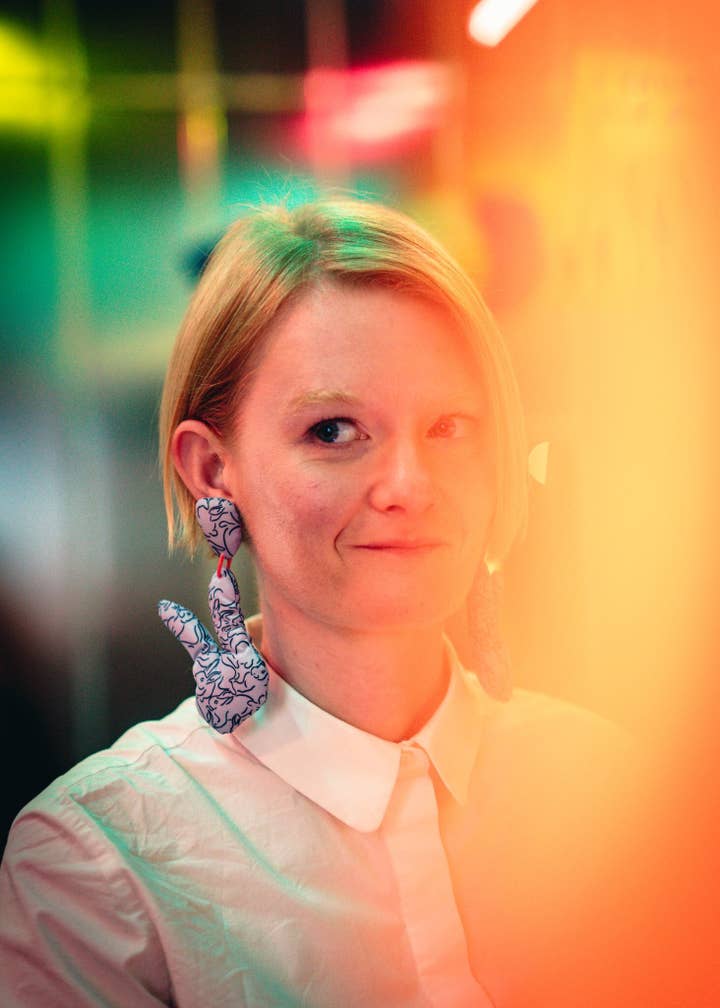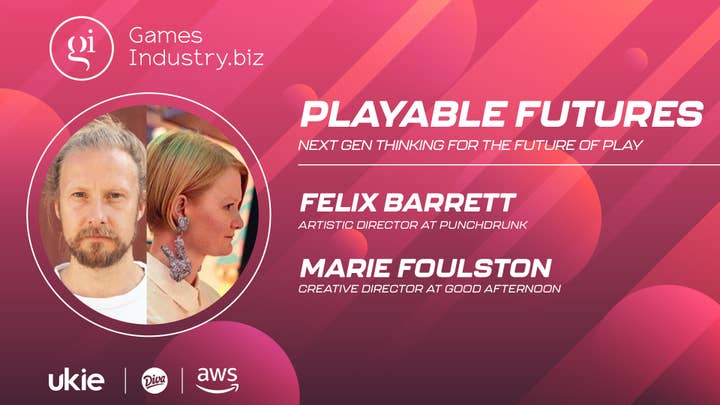How game making is shaping theatre and exhibition spaces | Playable Futures
Punchdrunk's artistic director Felix Barrett and Good Afternoon's creative director Marie Foulston consider how games are shaping their creations
This series of Playable Futures articles considers how the design, technology, people, and theory of video games are informing and influencing the wider world. You can find previous Playable Futures articles and podcasts here.
For decades, games' digital nature has been defining their very existence. They pull us away from reality into their virtual realms, never existing as physical reality.
Or, at least, that used to be the case. Over the years, phenomena like Pokemon Go have asserted that games that mix the digital and physical worlds can be wildly mainstream and successful. And yet there is another way in which the conventions and rulesets of the video game form are permeating our reality; namely, by increasingly shaping our experiences in public spaces. In particular, spaces such as theatre, galleries and museums are starting to see their output explicitly steered by conventions forged in the games industry.
"To be honest, we didn't explicitly plan that games would become so much of what we do," says Felix Barrett, artistic director at Punchdrunk, which stands as one of the most highly-regarded immersive theatre companies in the world. "After an initial run in the UK, we opened Sleep No More – our version of the Scottish play – in 2009. Towards the end of that year, American newspapers were doing their usual round-ups of the arts, and looking at theatre among other things. And in one of those papers, we saw Sleep No More described as the 'game of the year'. We were like: 'What? But we made a theatre show'.

"And then we started to see that it was just about this difference of vocabulary. The journalist simply used a gaming vocabulary to describe what we were thinking as just a different way of doing theatre. And that was a revelation for us. You could totally view Sleep No More as an open-world adventure game that our audience explores. Over time we've just started to see the theatre we make as having a lot of similarities with video games, and now we're really putting more of what games are into our work.
"It's just deliberate this time," Barrett says with a knowing laugh.
Immersive theatre covers a range of performance approaches, perhaps where the audience might mill about through a large set interacting with cast members, or discover elements of environmental storytelling as they explore. Some shows even let the audience influence or shape the narrative journey. With interaction part of the experience, then, it's not too testing to draw a comparison with how games function as a medium. And yet Punchdrunk's more recent work shows the overlap is about more than just the academic.
"As soon as we got that review,I realised there was a way we can be more methodical about this," Barrett continues, "If we take rulesets of video games and apply them to live-action theatre, we saw we could create a new form of entertainment. And actually that's the future of Punchdrunk's focus right now. So now I play games to analyse the mechanics. We're taking immersive theatre – which you can already compare to video games – but we're really looking at how we can take immersive theatre to new places by letting it be directly informed by video game design."
Barrett suspects his own youthful engagement with games – and an obsession with watching other people play titles like Resident Evil – might have something to do with the medium's stealthy cameo in his teams' earlier productions. But now the process is very deliberate. And so it is that Punchdrunk is now prototyping an immersive production that brings a physical take on platformers into the theatre.
Elsewhere, the team is considering ways that every audience member can take a game-like journey through a production as a character in the narrative. One of Punchdrunk's most recent works, The Burnt City, reimagines the Greek tragedies as events taking place in a neon-drenched metropolis. For the audience, that means exploring two warehouses containing over 100 rooms. They may not be able to influence the outcome of Punchdrunk's tale, but they can choose where to go, what to engage with, and what order they discover the narrative beats. They might even return to additional performances, exploring distinct routes, pursuing 'completion' of Punchdrunk's deliberate open-world adventure. Just like an avid open-world gamer.
"We're really looking at how we can take immersive theatre to new places by letting it be directly informed by video game design"
Felix Barrett, Punchdrunk
Away from theatre, gallery and exhibition spaces are equally undergoing a fascinating intersection with games. Marie Foulston, creative director at experiential specialists Good Afternoon, has forged a career working to make experiences in public spaces more effective and powerful.
Foulston, who served as lead curator on London's V&A museum's lauded gaming exhibition Design/Play/Disrupt, initially found herself working around film distribution. Despite her love for that medium, Foulson felt a pull to games. There she saw a beguiling openness to trying new things, creative exploration, and playfully defying expectations around the medium.
However, as Foulston started to try and connect with the game-making community, she found that many dev-centric meet-ups felt geared towards those with game-making chops, while expos were more commercially orientated, largely serving mainstream titles in a purely promotional context. And then she found Babycastles, the New York City collective that subverted the arcade setting to explore a diverse spread of games from a diverse set of voices.

"When I first saw Babycastles, I saw these amazing, experimental games in a grubby, grimy New York basement," Foulson reflects. "There were tangled wires and people playing with a beer in one hand. I realised this was a space that has energy that resonates with me, and I knew it would resonate with other people."
After looking into Babycastles – and comparable collective gatherings such as Montreal's nightlife-infused GAMMA events – Foulston established The Wild Rumpus, a UK-based collective that curated and produced indie game events globally. The main Wild Rumpus events were pitched as 'part arcade, part club night, part something wild and untamed that can't quite be put into words', and that's exactly how they felt to attend.
Over time, Foulston's work on Wild Rumpus led her to step up to take the reins of the aforementioned V&A exhibition, which was profoundly informed by elements of video game design.
"For the video games exhibition at the V&A, one of the things that I really loved about the collaboration was working with the project architects Pernilla Ohrstedt, as well as the digital-physical experience team from Squint/Opera, and graphic design studio Julia. We told them we really wanted to resist the cliches of pixels and labels like 'game over,' and further explore how we could go deeper into the medium and how it could be part of how we exhibited games at the V&A. And that's when we started to see what games are [start to] shape the exhibition.
"In the very first section of the exhibition, visitors would see these eight core games we'd focused on, each telling very different stories. Each game had its own discrete area, but they weren't their own rooms. The design of the main room meant you could stand at one end and see all the way to the other end. But intersecting that room were these large fabric scrims, and those screens sort of dampened the view of what you could see beyond them. And so you had this idea that you could see things in the distance that you were working towards, but it was as if these distant areas hadn't fully loaded yet."
"It's about designing a space to move through, where you want people to experience it in a certain way, while giving them freedom to explore. Really, exhibition design is a lot like level design in many ways"
Marie Foulston, Good Afternoon
Clearly, those vast scrims offered a take on video games' habit of shrouding distant areas in a 'fog,' bringing in more detail the closer you get to the likes of landmarks. It's a way to tempt curiosity, while guiding a user at the same time as giving them autonomy to explore. As it worked in games, so to did the method serve the Design/Disrupt/Play exhibition. The team also used lighting and highlighting to make certain objects and areas stand out, and draw attention – as seen in so many games that give interactive objects something of a shimmer or glow to guide the player towards them.
"I think for me, what that taught me in very concrete ways was that when we think about what game design is in a lot of contexts, it's about designing a space, and designing experience to move through; where you want people to experience it in a certain way, while giving them freedom to explore," Foulston offers. "That really works for exhibitions. Really, exhibition design is a lot like level design in many ways."
Put so eloquently, the connection seems rather obvious. Games in many cases are like pieces of theatre, or even exhibitions of play. So it makes sense that one can inform the other – in both directions.
"We're developing a thing that we've called PLAGE; the 'Punchdrunk live action game engine'," Barrett reveals. "It lets audience members' phones become almost like a Sheikah Slate in Breath of the Wild. It's not AR or anything like that. Rather, it gives the audience a tool so they can receive missions and information and store data and information as they adventure across hundreds of rooms of designed theatre space. And that's part of us thinking about how we could create a theatre experience where every audience member can feel like a hero, and be a character in the world."
A theatre-focused game engine? It appears the intersection of game design, theatre production and exhibition curation is just getting started.
Playable Futures is a collection of insights, interviews and articles from global games leaders sharing their visions of where the industry will go next. This article series has been brought to you by GamesIndustry.biz, Ukie, and Diva. You can find previous Playable Futures articles and podcasts here.

